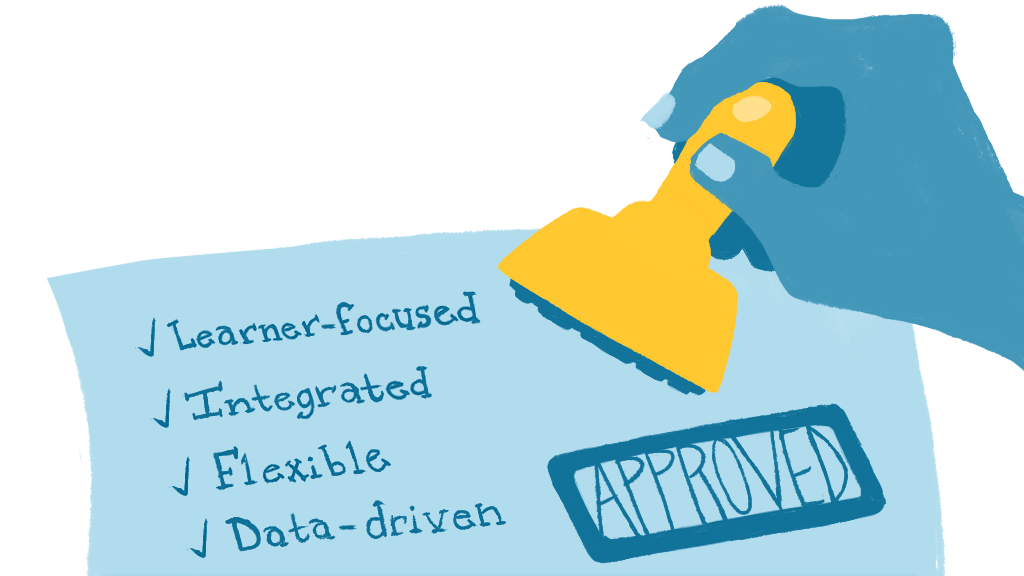Reimagine Learning
Assessment Design at Second Avenue Learning

Assessment is measurement, and there are many things worth measuring in learning environments. We want to know what learners know and what they can do so that we can tell whether learning objectives have been achieved and what role learning experiences played in helping people accomplish those objectives.
These notions aren’t especially controversial. What is tricky, though, are issues like these:
- What should we measure?
- How do we measure?
- Once we have effective measurements, what could we do with them?
These are the questions we ask when we design assessments. We leverage decades of combined experience and proven approaches to create assessments that are relevant, meaningful, clear, and fair. We use assessments to measure knowledge and skills, but that’s not all. We also measure what the learners are doing, their preferences, and how they solve problems. And while we know that good assessments provide information about the knowledge and skills possessed by the learners, we also use assessments to improve the learning experience itself. Assessment is measurement, but it doesn’t have to be only measurement.
At Second Avenue Learning, this is how we think about assessment design, and we make it happen by following these principles:
Focus on the Learner.
Every assessment is a communication with the learner, and it’s always important to know your audience. Why are they there? What do they know before they begin, and what do you want them to be able to do afterwards? Where are they likely to struggle? How are they different from each other, and how should those differences affect the experiences they get? These questions and others paint a picture of the learner that informs every aspect of the leaning design process, including assessment.
Good Assessments Start with Good Learning Objectives.
To measure effectively, you need to know what you’re measuring, which is one more reason why learning objectives are so important. Learning objectives define what the learners are supposed to be able to do, and assessments measure whether they can do those things. Clearly, then, these aspects of the learning experience need to be linked. Learning objectives need to be clear, relevant, realistic, and measurable. When learning objectives meet these standards, assessments can perform their functions well. But when the learning objectives themselves are flawed, assessment results can become meaningless. Unrealistic objectives will not be achieved. Unclear objectives lead to subjective results. Irrelevant objectives generate results that don’t matter. And unmeasurable objectives cannot be assessed at all.
Integrated Assessment is Better.
Assessment should not be an “add on,” tacked on after everything else is finished. It needs to be integrated into the entire learning process, including objectives, instruction, practice, and evaluation. Assessment should not be included just to have assessment. If should provide evidence and support conclusions that should be used to make learning experiences better. This means that assessment should be in lockstep with both learning objectives and the instructional content. If the skills people learn have nothing to do with the assessments, then something has gone seriously wrong. This does not mean that everyone should “teach to the test.” Rather, in a well-designed learning experience, everything works together to help learners achieve the relevant objectives.
Be Flexible and Creative with Assessments.
When people think of assessments, they tend to think of test questions, but assessments do not have to be graded tests, and they don’t have to be composed of familiar item types such as multiple choice, either. Sometimes, assessments measure opinions, preferences, or just patterns of usage. They can be used to determine grades, but they can also provide diagnostics to help learners identify their needs. Even within the bounds of traditional assessment formats, it is possible to measuring higher-order skills such as critical thinking, but sometimes the best assessments don’t feel like assessments to the learner. “Authentic” assessments bridge the gap between the test and the real world by asking learners to perform tasks that require mastery of learning objectives in a realistic scenario. In addition, games that provide problems to solve can also be assessments, and one of the best ways to find out how someone thinks and interacts is to see how they play. Game-based assessments that fit seamlessly into learning experiences can make learning more interactive and engaging while providing the information that good assessments offer.
Assessments Can Be Learning Experiences.
Assessments can do more than measure learning; they can also enhance learning by providing opportunities to practice, illustrating principles, and challenging learners to apply their skills in new scenarios. Sometimes the best way to learn something is to try it out and learn from our mistakes, and so assessments with low stakes or no stakes can give learners a safe place to practice and build confidence. Having a problem to solve provides motivation and can demonstrate the relevance of the content, which helps learners stay engaged. What’s more, while assessments have correct answers, they can have more than one correct answer, or perhaps multiple ways to get to the correct answer. Comparing approaches can help learners see alternatives and reflect on their own reasoning. Well-written explanations can help learners understand the concepts and processes behind the assessments, and working on assessments in groups can help them build communication and collaboration skills. Tests are made of assessments, but not every assessment needs to be a “test.”
Assessments Power Data-Driven Learning.
Assessments provide evidence required to understand learners and design better experiences for them. Of course, assessments tell us what the learners can do and where they are struggling, but sophisticated assessments can also tell us why the learners are having trouble by breaking down complex problems into simple ones. These insights can be used to design improvements to learning experiences, improvements that reflect reality instead of preconceptions. Surveys, usage patterns, and diagnostics can also provide a more accurate picture of the learner, which is always essential but especially important in agile development environments and when the learner population is itself in flux. Today’s great learning experiences need to continuously improve in order to stay great, and assessments can help make that happen.
Assessments Can Validate Effectiveness.
We’re used to thinking of assessments as measuring what learners can do, but they can also measure themselves and the learning experiences in which they are found. This is important, because if the learners are not performing as desired on the assessments, we need to know if the assessments themselves are the problem. (Sometimes they are.) Statistical analysis can determine whether assessments are reliable and valid indicators of learning outcomes, and this process can also identify which assessments are most effective at sorting out who has achieved the relevant learning objectives and who has not. This helps to identify and replace bad questions and prioritize the most useful ones. Once a set of assessments items is proven reliable and valid, it can be used to measure the effectiveness of learning experiences themselves.
Categories
- Accessibility (5)
- Blog (47)
- E-Learning and Serious Games (16)
- Election Edge (3)
- Guest Blogger (1)
- Learning Design (11)
- News (6)
- Primary Sources (4)
- Remote Learning (3)
- Second Avenue Voices (13)
- Teacher Tools (10)
- Technology (4)
- Uncategorized (9)
- Webinar (11)

